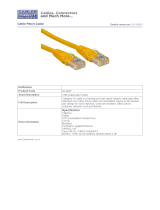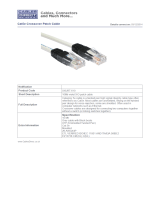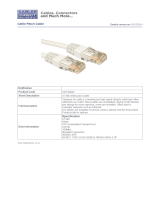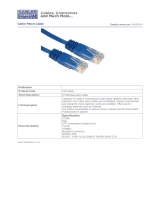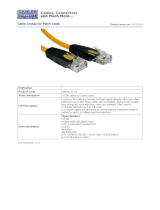Page is loading ...

Powered by Accton
www.edge-core.com
Installation Guide
Installationsanleitung
ES4016
ES4024
Gigabit Ethernet Switch

Installation Guide
Gigabit Ethernet Switch
Layer 2 Workgroup Switch
with 16/24 10/100/1000BASE-T (RJ-45) Ports

i
Compliances and Safety Warnings
FCC - Class A
This equipment has been tested and found to comply with the limits for a Class A digital
device, pursuant to part 15 of the FCC Rules. These limits are designed to provide
reasonable protection against harmful interference when the equipment is operated in a
commercial environment. This equipment generates, uses, and can radiate radio
frequency energy and, if not installed and used in accordance with the instruction manual,
may cause harmful interference to radio communications. Operation of this equipment in
a residential area is likely to cause harmful interference in which case the user will be
required to correct the interference at his own expense.
You are cautioned that changes or modifications not expressly approved by the party
responsible for compliance could void your authority to operate the equipment.
You may use unshielded twisted-pair (UTP) for RJ-45 connections - Category 3 or better
for 10 Mbps connections, Category 5 or better for 100 Mbps connections, Category 5, 5e,
or 6 for 1000 Mbps connections. For fiber optic connections, you may use 50/125 or 62.5/
125 micron multimode fiber or 9/125 micron single-mode fiber.
Industry Canada - Class A
This digital apparatus does not exceed the Class A limits for radio noise emissions from
digital apparatus as set out in the interference-causing equipment standard entitled
“Digital Apparatus,” ICES-003 of the Department of Communications.
Cet appareil numérique respecte les limites de bruits radioélectriques applicables aux
appareils numériques de Classe A prescrites dans la norme sur le matériel brouilleur:
“Appareils Numériques,” NMB-003 édictée par le ministère des Communications.
Japan VCCI Class A

ii
CE Mark Declaration of Conformance for EMI and Safety (EEC)
This information technology equipment complies with the requirements of the Council
Directive 89/336/EEC on the Approximation of the laws of the Member States relating to
Electromagnetic Compatibility and 73/23/EEC for electrical equipment used within certain
voltage limits and the Amendment Directive 93/68/EEC. For the evaluation of the
compliance with these Directives, the following standards were applied:
Caution: Do not plug a phone jack connector in the RJ-45 port. This may damage this
device.
Attention: Les raccordeurs ne sont pas utilisés pour le système téléphonique!
Australia AS/NZS 3548 (1995) - Class A
RFI Emission: • Limit class A according to EN 55022:1998
• Limit class A for harmonic current emission according to EN 61000-3-2/1995
• Limitation of voltage fluctuation and flicker in low-voltage supply system
according to EN 61000-3-3/1995
Immunity: • Product family standard according to EN 55024:1998
• Electrostatic Discharge according to EN 61000-4-2:1995
(Contact Discharge: ±4 kV, Air Discharge: ±8 kV)
• Radio-frequency electromagnetic field according to EN 61000-4-3:1996
(80 - 1000 MHz with 1 kHz AM 80% Modulation: 3 V/m)
• Electrical fast transient/burst according to EN 61000-4-4:1995 (AC/DC power
supply: ±1 kV, Data/Signal lines: ±0.5 kV)
• Surge immunity test according to EN 61000-4-5:1995
(AC/DC Line to Line: ±1 kV, AC/DC Line to Earth: ±2 kV)
• Immunity to conducted disturbances, Induced by radio-frequency fields:
EN 61000-4-6:1996 (0.15 - 80 MHz with 1 kHz AM 80% Modulation: 3 V/m)
• Power frequency magnetic field immunity test according to
EN 61000-4-8:1993
(1 A/m at frequency 50 Hz)
• Voltage dips, short interruptions and voltage variations immunity test
according to EN 61000-4-11:1994 (>95% Reduction @10 ms, 30%
Reduction @500 ms, >95% Reduction @5000 ms)
LVD: • EN 60950-1:2001
ACN 066 352 010

iii
Please read the following safety information carefully before
installing the switch:
WARNING: Installation and removal of the unit must be carried out by qualified personnel
only.
• The unit must be connected to an earthed (grounded) outlet to comply with international
safety standards.
• Do not connect the unit to an A.C. outlet (power supply) without an earth (ground)
connection.
• The appliance coupler (the connector to the unit and not the wall plug) must have a
configuration for mating with an EN 60320/IEC 320 appliance inlet.
• The socket outlet must be near to the unit and easily accessible. You can only remove
power from the unit by disconnecting the power cord from the outlet.
• This unit operates under SELV (Safety Extra Low Voltage) conditions according to
IEC 60950. The conditions are only maintained if the equipment to which it is connected
also operates under SELV conditions.
France and Peru only
This unit cannot be powered from IT
†
supplies. If your supplies are of IT type, this unit
must be powered by 230 V (2P+T) via an isolation transformer ratio 1:1, with the
secondary connection point labelled Neutral, connected directly to earth (ground).
†
Impédance à la terre
Power Cord Set
U.S.A. and Canada The cord set must be UL-approved and CSA certified.
The minimum specifications for the flexible cord are:
- No. 18 AWG - not longer than 2 meters, or 16 AWG.
- Type SV or SJ
- 3-conductor
The cord set must have a rated current capacity of at least 10 A
The attachment plug must be an earth-grounding type with NEMA
5-15P (15 A, 125 V) or NEMA 6-15P (15 A, 250 V) configuration.
Denmark The supply plug must comply with Section 107-2-D1, Standard
DK2-1a or DK2-5a.
Switzerland The supply plug must comply with SEV/ASE 1011.
U.K. The supply plug must comply with BS1363 (3-pin 13 A) and be fitted
with a 5 A fuse which complies with BS1362.
The mains cord must be <HAR> or <BASEC> marked and be of type
HO3VVF3GO.75 (minimum).
Europe The supply plug must comply with CEE7/7 (“SCHUKO”).
The mains cord must be <HAR> or <BASEC> marked and be of type
HO3VVF3GO.75 (minimum).
IEC-320 socket.

v
Bitte unbedingt vor dem Einbauen des Switches die folgenden
Sicherheitsanweisungen durchlesen:
WARNUNG: Die Installation und der Ausbau des Geräts darf nur durch Fachpersonal
erfolgen.
• Das Gerät sollte nicht an eine ungeerdete Wechselstromsteckdose angeschlossen
werden.
• Das Gerät muß an eine geerdete Steckdose angeschlossen werden, welche die
internationalen Sicherheitsnormen erfüllt.
• Der Gerätestecker (der Anschluß an das Gerät, nicht der Wandsteckdosenstecker) muß
einen gemäß EN 60320/IEC 320 konfigurierten Geräteeingang haben.
• Die Netzsteckdose muß in der Nähe des Geräts und leicht zugänglich sein. Die
Stromversorgung des Geräts kann nur durch Herausziehen des Gerätenetzkabels aus
der Netzsteckdose unterbrochen werden.
• Der Betrieb dieses Geräts erfolgt unter den SELV-Bedingungen
(Sicherheitskleinstspannung) gemäß IEC 60950. Diese Bedingungen sind nur gegeben,
wenn auch die an das Gerät angeschlossenen Geräte unter SELV-Bedingungen
betrieben werden.
Warnings and Cautionary Messages
Stromkabel. Dies muss von dem Land, in dem es benutzt wird geprüft werden:
Schweiz Dieser Stromstecker muß die SEV/ASE 1011Bestimmungen einhalt-
en.
Europe Das Netzkabel muß vom Typ HO3VVF3GO.75 (Mindestanforderung)
sein und die Aufschrift <HAR> oder <BASEC> tragen.
Der Netzstecker muß die Norm CEE 7/7 erfüllen (”SCHUKO”).
Warning: This product does not contain any serviceable user parts.
Warning: Installation and removal of the unit must be carried out by qualified
personnel only.
Warning: When connecting this device to a power outlet, connect the field ground lead
on the tri-pole power plug to a valid earth ground line to prevent electrical
hazards.
Caution: Do not plug a phone jack connector in the RJ-45 port. This may damage this
device. Les raccordeurs ne sont pas utilisé pour le système téléphonique!
Caution: Use only twisted-pair cables with RJ-45 connectors that conform to FCC
standards.
Caution: Wear an anti-static wrist strap or take other suitable measures to prevent
electrostatic discharge when handling this equipment.

vi
Warnings (In German)
Environmental Statement
The manufacturer of this product endeavours to sustain an environmentally-friendly policy
throughout the entire production process. This is achieved though the following means:
• Adherence to national legislation and regulations on environmental production
standards.
• Conservation of operational resources.
• Waste reduction and safe disposal of all harmful un-recyclable by-products.
• Recycling of all reusable waste content.
• Design of products to maximize recyclables at the end of the product’s life span.
• Continual monitoring of safety standards.
End of Product Life Span
This product is manufactured in such a way as to allow for the recovery and disposal of all
included electrical components once the product has reached the end of its life.
Manufacturing Materials
There are no hazardous nor ozone-depleting materials in this product.
Documentation
All printed documentation for this product uses biodegradable paper that originates from
sustained and managed forests. The inks used in the printing process are non-toxic.
Purpose
This guide details the hardware features of the switch, including the physical and
performance-related characteristics, and how to install the switch.
Audience
The guide is intended for use by network administrators who are responsible for installing
and setting up network equipment; consequently, it assumes a basic working knowledge
of LANs (Local Area Networks).
Diese Anleitung ist für die Benutzung durch Netzwerkadministratoren vorgesehen, die für
die Installation und das einstellen von Netzwerkkomponenten verantwortlich sind; sie
setzt Erfahrung bei der Arbeit mit LANs (Local Area Networks) voraus.
Achtung:
Dieses Produkt enthält keine Teile, die eine Wartung vom Benutzer
benötigen.
Achtung: Wenn das Gerät an eine Steckdose angeschlossen wird, muß der
Masseanschluß am dreipoligen Netzstecker mit Schutzerde verbunden
werden, um elektrische Gefahren zu vermeiden.

vii
Contents
Chapter 1: Introduction 1-1
Overview 1-1
Switch Architecture 1-2
Description of Hardware 1-2
10/100/1000BASE-T Ports 1-2
Port and System Status LEDs 1-2
Power Supply Socket 1-3
Features and Benefits 1-4
Connectivity 1-4
Performance 1-4
Chapter 2: Network Planning 2-1
Introduction to Switching 2-1
Application Examples 2-2
Collapsed Backbone 2-2
Network Aggregation Plan 2-3
Application Note 2-4
Chapter 3: Installing the Switch 3-1
Selecting a Site 3-1
Ethernet Cabling 3-1
Equipment Checklist 3-2
Package Contents 3-2
Optional Rack-Mounting Equipment 3-2
Mounting 3-3
Rack Mounting 3-3
Desktop or Shelf Mounting 3-4
Connecting to a Power Source 3-5
Chapter 4: Making Network Connections 4-1
Connecting Network Devices 4-1
Twisted-Pair Devices 4-1
Cabling Guidelines 4-1
Connecting to PCs, Servers, Hubs and Switches 4-1
Network Wiring Connections 4-2
Connectivity Rules 4-3
1000BASE-T Cable Requirements 4-3

Contents
viii
1000 Mbps Gigabit Ethernet Collision Domain 4-3
100 Mbps Fast Ethernet Collision Domain 4-3
10 Mbps Ethernet Collision Domain 4-3
Cable Labeling and Connection Records 4-4
Appendix A: Troubleshooting A-1
Diagnosing Switch Indicators A-1
Power and Cooling Problems A-1
Installation A-1
Appendix B: Cables B-1
Twisted-Pair Cable and Pin Assignments B-1
10BASE-T/100BASE-TX Pin Assignments B-1
Straight-Through Wiring B-2
Crossover Wiring B-2
1000BASE-T Pin Assignments B-3
Appendix C: Specifications C-1
Switch Features C-2
Standards C-2
Compliances C-3
Appendix D: German Instructions D-1
Eine Site auswahlen (Selecting a Site - German) D-1
Montage (Rack Mounting Instructions - German) D-2
Rack-Montage D-2
Anschluss an eine Stromquelle (Connecting to a Power Source - German) D-3
Glossary
Index

xi
Tables
Table 1-1 ES4016 / ES4024 Port Status LEDs 1-3
Table 1-2 ES4016 / ES4024 System Status LEDs 1-3
Table 4-1. Maximum Gigabit Ethernet Cable Length 4-3
Table 4-2. Maximum Fast Ethernet Cable Length 4-3
Table 4-3. Maximum Ethernet Cable Length 4-3
Table A-1. Troubleshooting Chart A-1
Table B-1. 10/100BASE-TX MDI and MDI-X Port Pinouts B-2
Table B-2. 1000BASE-T MDI and MDI-X Port Pinouts B-3

Tab les
xii

xii
Figures
Figure 1-1. ES4016 Front and Rear Panels 1-1
Figure 1-2. ES4024 Front and Rear Panels 1-1
Figure 1-3. ES4016 Port and System Status LEDs 1-2
Figure 1-4. ES4024 Port and System Status LEDs 1-3
Figure 1-5. ES4016/ES4024 Power Supply Socket 1-3
Figure 2-1. Collapsed Backbone 2-2
Figure 2-2. Network Aggregation Plan 2-3
Figure 3-1. RJ-45 Connections 3-2
Figure 3-2. Attaching the Brackets 3-3
Figure 3-3. Installing the Switch in a Rack 3-4
Figure 3-4. Attaching the Adhesive Feet 3-4
Figure 3-5. Power Socket 3-5
Figure 4-1. Making Twisted-Pair Connections 4-1
Figure 4-2. Network Wiring Connections 4-2
Figure B-1. RJ-45 Connector Pin Numbers B-1
Figure B-2. Straight-through Wiring B-2
Figure B-3. Crossover Wiring B-3

1-1
Chapter 1: Introduction
Overview
These switches are high-performance Gigabit Ethernet switches designed for
delivering Gigabit connectivity to the desktop. They provide 16/24 full-duplex
1000BASE-T ports that significantly improve network performance and boost
throughput for high-bandwidth applications. With 32/48 Gigabits of aggregate
bandwidth, these switches provide the quickest solution to meeting the growing
demands on your network's limited resources.
Figure 1-1. ES4016 Front and Rear Panels
Figure 1-2. ES4024 Front and Rear Panels
10/100/1000 Mbps RJ-45 Ports
System Indicators
Power Socket
Port Status Indicators
10/100/1000 Mbps RJ-45 Ports
System Indicators
Power Socket
Port Status Indicators

Introduction
1-2
1
Switch Architecture
These switches employ a wire-speed, non-blocking switching fabric. This permits
simultaneous wire-speed transport of multiple packets at low latency on all ports.
These switches also features full-duplex capability on all ports, which effectively
doubles the bandwidth of each connection.
These switches use store-and-forward switching to ensure maximum data integrity.
With store-and-forward switching, the entire packet must be received into a buffer
and checked for validity before being forwarded. This prevents errors from being
propagated throughout the network.
Description of Hardware
10/100/1000BASE-T Ports
These switches contain 16/24 RJ-45 ports that operate at 10 Mbps or 100 Mbps, half
or full duplex, or 1000 Mbps, full duplex. Because all ports on both switches support
automatic MDI/MDI-X operation, you can use straight-through cables for all network
connections to PCs or servers, or to other switches or hubs. (See “10BASE-T/
100BASE-TX Pin Assignments” on page B-1.)
Each of these ports support auto-negotiation, so the optimum transmission mode
(half or full duplex), and data rate (10, 100, or 1000 Mbps) can be selected
automatically.
Each port also supports auto-negotiation of flow control, so the switch can
automatically prevent port buffers from becoming saturated.
Port and System Status LEDs
The LEDs, which are located on the front panel for easy viewing, are shown below
and described in the following table.
Figure 1-3. ES4016 Port and System Status LEDs
Port Status LEDs
System Status LEDs

Description of Hardware
1-3
1
Figure 1-4. ES4024 Port and System Status LEDs
Power Supply Socket
There is one standard power socket on the rear panel of each switch for the AC
power cord.
Figure 1-5. ES4016/ES4024 Power Supply Socket
Table 1-1 ES4016 / ES4024 Port Status LEDs
LED Condition Status
RJ-45 Ports
Link/ACT
(Link/Activity)
On/Flashing
Green
The port has established a valid network connection.
Flashing indicates activity.
Off There is no valid link on the port.
100M/1000M On Green The port has a valid 1000 Mbps link.
On Yellow The port has a valid 100 Mbps link.
Off When the Link LED is on, indicates the port has a valid
10 Mbps link.
Table 1-2 ES4016 / ES4024 System Status LEDs
LED Condition Status
PWR
(Power)
On Green Internal power is operating normally.
Off Power off or failure.
Port Status LEDs
System Status LEDs
Power Socket

Introduction
1-4
1
Features and Benefits
Connectivity
• 16/24 10/100/1000BASE-T RJ-45 ports.
• Auto-negotiation enables each RJ-45 port to automatically select the optimum
speed (10, 100, or 1000 Mbps), and the communication mode (half or full duplex)
if this feature is supported by the attached device.
• Independent RJ-45 10/100/1000BASE-T ports with auto MDI/MDI-X pinout
selection.
• Unshielded (UTP) cable supported on all RJ-45 ports: Category 3, 4 or 5 for
10 Mbps connections, Category 5 for 100 Mbps connections, and Category 5 or
better for 1000 Mbps connections.
• IEEE 802.3-2005 Ethernet, Fast Ethernet, Gigabit Ethernet compliance ensures
compatibility with standards-based hubs, network cards and switches from any
vendor.
• “At-a-glance” LEDs for port and system status monitoring.
• Desktop installation.
Performance
• Transparent bridging
• Switching table with a total of 8K MAC address entries
• Provides store-and-forward switching
• Support for 9 KB jumbo frames
• Supports wire-speed filtering and forwarding
• Supports flow control, using back pressure for half duplex and IEEE 802.3x for full
duplex
• Broadcast storm control

2-1
Chapter 2: Network Planning
Introduction to Switching
A network switch allows simultaneous transmission of multiple packets via
non-crossbar switching. This means that it can partition a network more efficiently
than bridges or routers. The switch has, therefore, been recognized as one of the
most important building blocks for today’s networking technology.
When performance bottlenecks are caused by congestion at the network access
point (such as the network card for a high-volume file server), the device
experiencing congestion (server, power user, or hub) can be attached directly to a
switched port. And, by using full-duplex mode, the bandwidth of the dedicated
segment can be doubled to maximize throughput.
When networks are based on repeater (hub) technology, the distance between end
stations is limited by a maximum hop count. However, a switch turns the hop count
back to zero. So subdividing the network into smaller and more manageable
segments, and linking them to the larger network by means of a switch, removes this
limitation.
A switch can be easily configured in any Ethernet, Fast Ethernet, or Gigabit Ethernet
network to significantly boost bandwidth while using conventional cabling and
network cards.

2-2
Network Planning
2
Application Examples
These switches are not only designed to segment your network, but also to provide
a wide range of options in setting up network connections. Some typical applications
are described in the following pages.
Collapsed Backbone
These switches are an excellent choice for mixed Ethernet, Fast Ethernet, and
Gigabit Ethernet installations where significant growth is expected in the near future.
In a basic stand-alone configuration, it can provide direct full-duplex connections to
workstations or servers. When the time comes for further expansion, just connect to
another hub or switch using one of the Gigabit Ethernet ports built into the front
panel.
In the figure below, the switch is operating as a collapsed backbone for a small LAN.
It is providing dedicated 100 Mbps full-duplex connections to workstations and
1000 Mbps full-duplex connections to power users and servers.
Figure 2-1. Collapsed Backbone

2-3
Application Examples
2
Network Aggregation Plan
With 16 or 24 parallel bridging ports (i.e., 16 or 24 distinct collision domains), the
switch can collapse a small network down into a single efficient bridged node,
increasing overall bandwidth and throughput.
In the figure below, the ports on the switch are providing 100 Mbps connectivity
through layer 2 switches. In addition, the switch is also connecting several servers at
1000 Mbps.
Figure 2-2. Network Aggregation Plan

2-4
Network Planning
2
Application Note
Full-duplex operation only applies to point-to-point access (such as when a switch is
attached to a workstation, server or another switch). When the switch is connected
to a hub, both devices must operate in half-duplex mode.
/
